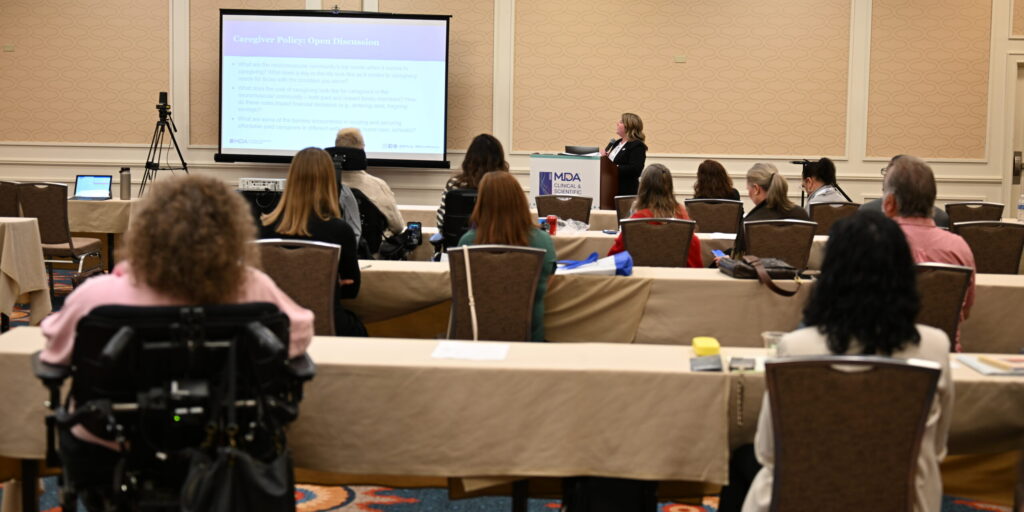
Understanding Myositis
By Myrna Traylor | Tuesday, August 13, 2024

Tahseen Mozaffar, MD
Myositis, a chronic inflammation of the skeletal muscles (muscles that connect to bones), can cause symptoms similar to those experienced by people with muscular dystrophy, including muscle weakness and fatigue.
To learn more about myositis, Quest Media spoke with Tahseen Mozaffar, MD, a neuromuscular neurologist at the University of California, Irvine, and director of the UC Irvine-MDA ALS and Neuromuscular Center, who has been studying this group of diseases for 30 years.
What is myositis?
Myositis is not a muscular dystrophy. Muscular dystrophies are usually inherited. Myositis is an acquired disease that causes inflammation in the muscles. It could be related to patient susceptibility to autoimmune conditions, or it could be in response to environmental factors. It primarily affects the skeletal muscles, causing significant disability from muscle weakness, but there also can be involvement of the respiratory muscles — the diaphragm or ribcage muscles — which can make it difficult to breathe in enough oxygen, blow out enough carbon dioxide, or clear airway secretions, increasing risk for pneumonia. In very rare instances, myositis can cause inflammation in the heart, where it becomes myocarditis, which can make it harder for the heart to pump blood.
There are five forms of primary myositis. The four more common types of myositis are dermatomyositis, immune-mediated necrotizing myopathy, anti-synthetase syndrome, and inclusion-body myositis (IBM). The fifth type, polymyositis, is considered extremely rare and likely overdiagnosed.
How is myositis diagnosed?
Muscular dystrophies usually manifest over years, whereas myositis can manifest within weeks or months. It’s a much shorter period of onset compared to muscular dystrophy, but both will present with muscle weakness. If a myositis patient comes to a physician’s attention later in their disease course, patients may be misdiagnosed with muscular dystrophy.
A myositis diagnosis will involve a patient history, blood tests for muscle enzymes, muscle and skin biopsies, and perhaps MRI scans, nerve conduction, and electromyogram tests.
How is myositis treated?
Although there is no cure for myositis, there are several treatments that can help, including corticosteroids or other immunosuppressants; intravenous immunoglobulin; or in some cases, monoclonal antibodies, such as rituximab.
Also, some drugs for myasthenia gravis (MG), such as efgartigimod, are being tested for myositis. One example is a class of drugs called CD19 inhibitors, which are being used in multiple sclerosis, as well as MG. There is significant overlap with the underlying immune process among myasthenia gravis, multiple sclerosis, and myositis, so some of these drugs can be cross-utilized.
Are there other treatment options on the horizon?
There are a number of clinical trials currently enrolling using some of the same drugs that have been approved for lupus and rheumatoid arthritis, which also involve an immune response.
We’re also doing cutting-edge research using CAR T-cell therapy, which is employed in cancer treatments. In CAR T-cell therapy, T lymphocytes (immune cells) are extracted from a patient’s own blood and modified to make them target-specific antigens that target antibody producing B and plasma cells (antigens such as CD19 or B-cell maturation antigen (BCMA). The T lymphocytes are reintroduced to the patient’s system, where they destroy these immune cells, reset the muscle cells, and reduce the inflammatory response.
Myrna Traylor is a writer for Quest Media.
Types of Primary Myositis
- Inclusion-body myositis (IBM) is an autoimmune disorder that occurs when inflammatory cells infiltrate the spaces between muscle fibers. Although it is generally painless, this form of myositis causes progressive muscle weakness in the arms, hands, and legs, as well as in the neck and esophagus. Disease onset usually begins in the 50s.
- Dermatomyositis is an autoimmune disorder that occurs when inflammatory cells attack the small blood vessels that supply muscles and skin. This causes muscle weakness and a discolored rash. These two symptoms may show up at the same time, or months or years apart. Muscle weakness usually occurs in the shoulders, upper arms, hips, and thighs. Dermatomyositis usually occurs in children 5 to 15 years old or adults 40 to 60 years old. People assigned female at birth are more likely to have the disease.
- Immune-mediated necrotizing myopathy (IMNM) occurs when the immune system attacks muscle fibers, leading to cell death (necrosis). It mainly affects adults, causing weakness in the hips and thighs. It may be misdiagnosed as limb-girdle muscular dystrophy (LGMD). Like the other myositis types, the exact cause is not known; however, IMNM can be a side effect of the use of the group of cholesterol-lowering drugs known as statins. People who receive prescriptions for statins should ask their physicians for muscle enzyme tests before and during treatment to check for the possible development of IMNM.
- Anti-synthetase syndrome (ASS) is an autoimmune disease affecting multiple systems of the body. In addition to causing muscle weakness in the shoulders and hips, it may cause symptoms on the skin that can be mistaken for dermatomyositis. However, many people with ASS also have severe arthritis and interstitial lung disease, which causes fibrosis (scarring) of the lungs. Onset can start in the late teens, but people over 50 are more likely to have it.
- Polymyositis is believed to be an autoimmune disorder in which immune cells attack muscle fibers, causing inflammation and weakness in the muscles closest to the trunk of the body. It is twice as likely to occur in those assigned female at birth but rarely occurs in people under age 18. Polymyositis is considered to be very uncommon and probably accounts for <2% of all myositis.
Next Steps and Useful Resources
- Stay up-to-date on Quest content! Subscribe to Quest Magazine and Newsletter.
TAGS: Featured Content, Research, Research Advances, Spotlight
TYPE: Featured Article
Disclaimer: No content on this site should ever be used as a substitute for direct medical advice from your doctor or other qualified clinician.




